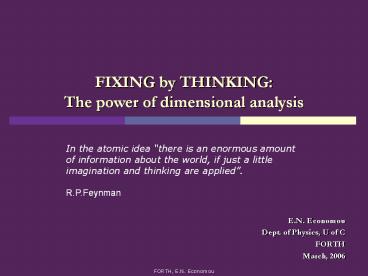FIXING by THINKING: The power of dimensional analysis - PowerPoint PPT Presentation
Title:
FIXING by THINKING: The power of dimensional analysis
Description:
FIXING by THINKING: The power of dimensional analysis In the atomic idea there is an enormous amount of information about the world, if just a little imagination ... – PowerPoint PPT presentation
Number of Views:38
Avg rating:3.0/5.0
Title: FIXING by THINKING: The power of dimensional analysis
1
FIXING by THINKINGThe power of dimensional
analysis
In the atomic idea there is an enormous amount
of information about the world, if just a little
imagination and thinking are applied. R.P.Feynma
n
- E.N. Economou
- Dept. of Physics, U of C
- FORTH
- March, 2006
2
- ATOMIC NATURE OF MATTER ( FORCES)
- WAVE/ PARTICLE DUALITY?QUANTUM MECHANICS
- (a) Heisenberg Principle
-
- (b) Pauli Principle
- (c) Schrödinger Principle
- EQUILIBRIUM STRUCTURES ? MINIMIZATION OF (FREE)
ENERGY (M.E)
or
or
3
- NEEDED ALSO
- Strong force range 1 4 fm, strength 1 100
MeV - Weak force ,
- Em force
- Gravity
- AND THE NUMERICAL VALUES OF
- , , , , ,
4
M.E. ? Equality of Compressive expansive
pressure
Length Scale (m) Stable Structures Potential Energy Kinetic Energy
10-15 -10-14 Nuclei Strong Interaction Quantum Kinetic Energy/ Electrostatic
10-10 Atoms Electrostatic Quantum Kinetic Energy
10-10- Molecules
?10-7 Solids/Liquids
?105 Asteroids
107 Planets Electrostatic Gravitational
109 Stars Gravitational Quantum Kinetic Energy/ Thermal Kinetic Energy
107 White Dwarfs Gravitational Quantum Kinetic Energy
104 Neutron stars Gravitational
104 ? Black Holes Gravitational
1026 Universe Gravitational Expansion kinetic energy/ Dark energy
Electromagnetic Strong/Weak
5
Limits setting universal constants
Forces
Particles (spin ½)
Name/ Symbol ?ass (?eV) Electric charge Name Strength Range
Electron e -e Gravitational
Proton p e E/?
Neutron n 0 Weak Nuclear n?p 10-18 m
Netrino ? 0 Strong Nuclear
6
Mass of proton neutron is the kinetic energy
of the quarks
Exp. 938.27
Exp. 939.57
7
Nuclei ANZ
- Strong Interactions
-
- Coulomb Interactions
- Kinetic Energy
8
- FROM ATOMS TO ASTEROIDS THE POTENTIAL ENERGY IS
CHARACTERISED BY - THE KINETIC ENERGY IS CHARACTERISED BY
- AND
- INSTEAD OF USE
- OTHERS
9
Atoms
,
,
- fa increases as we move down the columns of the
P.T.E. - fa local minimum for completed p and s/d orbitals
- fa local maximum for ,
10
1 1H Periodic Table of Elements Periodic Table of Elements Periodic Table of Elements Periodic Table of Elements Periodic Table of Elements Periodic Table of Elements Periodic Table of Elements Periodic Table of Elements Periodic Table of Elements Periodic Table of Elements Periodic Table of Elements 2He
2 3Li 4Be 5B 6C 7N 8O 9F 10Ne
3 11Na 12Mg 13Al 14Si 15P 16S 17Cl 18Ar
4 19K 20Ca 21Sc 22Ti 23V 24Cr 25Mn 26Fe 27Co 28Ni 29Cu 30Zn 31Ga 32Ge 33As 34Se 35Br 36Kr
5 37Rb 38Sr 39Y 40Zr 41Nb 42Mo 43Tc 44Ru 45Rh 46Pd 47Ag 48Cd 49In 50Sn 51Sb 52Te 53I 54Xe
6 55Cs 56Ba 57La 1 72Hf 73Ta 74W 75Re 76Os 77Ir 78Pt 79Au 80Hg 81Tl 82Pb 83Bi 84Po 85At 86Rn
7 87Fr 88Ra 89Ac 2 104Rf 105Db 106Sg 107Bh 108Hs 109Mt 110Uun 111Uuu 112Uub 114Uuq 116Uuh 118Uuo
6 1 58Ce 59Pr 60Nd 61Pm 62Sm 63Eu 64Gd 65Tb 66Dy 67Ho 68Er 69Tm 70Yb 71Lu
7 2 90Th 91Pa 92U 93Np 94Pu 95Am 96Cm 97Bk 98Cf 99Es 100Fm 101Md 102No 103Lr
11
- Local Maxima for completed p, s/d orbitals
- Local Minima for completed p, s/d orbitals plus 1
12
Molecules
exception noble gases
,
,
13
Solids
,
,
,
14
Solids
,
15
Comparison with experimental data
Si
Cu
Al
Fe
Theory
Exp.
Theory
Exp.
Theory
Exp.
Theory
Exp.
3,18
2,67
2,99
2,67
2,36
2,33
9,01
8,96
2,73
2,79
7,92
7,86
(gr/cm3)
2,69
4,63
3,82
3,49
3,04
3,39
3,82
4,28
(eV/atom)
0,54
0,998
1,29
1,37
0,73
0,722
1,29
1,68
B ( )
4,87
6,48
3,85
3,93
5,28
5,68
4,11
4,63
(?m/s)
16
FLUIDS
- Sea waves
,
17
exp 0.073 J/m2
18
TSUNAMI
WIND INDUCED
?(m)
1.7 cm
19
FLUIDS
- Drag force
,
, LARGE BODIES, HIGH SPEED
,
, SMALL BODIES, LOW SPEED
Reynolds number
water 0.01 0.01
air 0.00018 0.15
20
exp
21
Black Body Radiation
22
Planets
- Size
- Spherical shape ?
- AVERAGE TEMPERATURE
,
23
Typical Planet EGRAVITATIONAL ? ?ELECTRIC
24
- Why Earth is round?
- Why are there mountains?
- What is the largest possible height of a mountain
in a planet? - When the shear stress exceeds the critical value
,
25
Planets
Jupital
Pluto
26
STARS
- MINIMUM NUMBER OF NUCLEONS
- MAXIMUM NUMBER OF NUCLEONS
- NUMBER OF NUCLEONS IN OUR SUN
- MAXIMUM NUMBER OF NUCLEONS IN A WHITE DWARF
,
27
STARS ?min
T
Tmax
Tign
0
R
28
STARS ?max
For large mass, T becomes large, Eph dominates
over Ekin then
29
Black Holes
1. 2. 3. 4.
years
30
Universe
- Homogeneous Isotropic
- Expanding according to Hubbles law
- Eucledian geometry (as a result of inflation)
- 1st LAW (for dS?0) dUd(eV)-pdV
- Three unknown functions R(t), e(t), p(t)
(1)
(2)
31
OBSERVATIONS WMAP Wilkinson Microwave Anisotropy
Probe
32
(No Transcript)
33
(No Transcript)
34
- the
equivalent of 6 protons per m3 - This density equals to the critical one with an
uncertainty of 2 - protons per m3, i.e. about 4.2
of e - The Rest
- DARK MATTER
- DARK ENERGY
35
,
- accelerated expansion
- today
- for
- for
36
BB
q?B
P,n?nuclei
eph?enucl
decoupling
Protostars
Galaxies
Today
10-4s
1s
70 ky
380 ky
180 My
8 Gy
13.7 Gy
500 My
t































